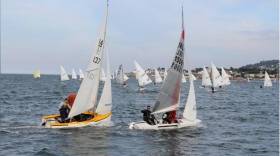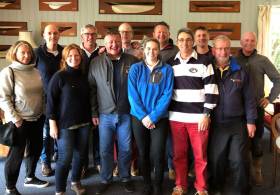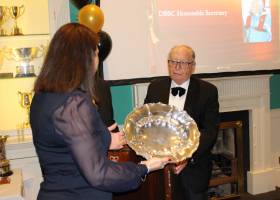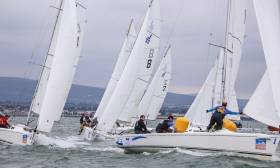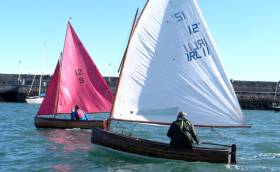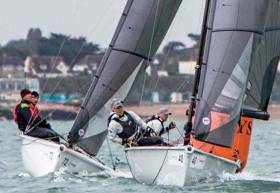Displaying items by tag: Royal St George Yacht Club
Dublin Bay Dinghies Will Have Final Fling at Royal St.George Yacht Club
The mixed Dublin Bay dinghy fleet will have a four-race final race day on September 29th to round out the summer sailing season.
According to organiser Ross O'Leary, the event will provide 'fun sprint racing' for all levels with a party afterwards at the Royal St. George Yacht Club.
Regular Dublin Bay classes such as the new foiling Waszp, the IDRA 14s, Laser, Fireball and Fevas are targeted but all are welcome.
The Notice of Race is downloadable below. Online entry is here.
The Frank Keane BMW Royal St. George Yacht Club Regatta brought to a close June's Dun Laoghaire Waterfront Regatta weekends with yet another stunning set of sailing conditions for the two-race racing festival on the first Saturday in July.
Full results in all 28 divisions are downloadable below in a PDF file.
A 10-14–knot south-easterly gradient produced T-shirts and shorts sailing conditions for most of the crews in the cruiser classes and for some of the one design classes too as the heatwave continues across Ireland. Race officer Eddie Totterdell ran the cruiser divisions from DBSC's Mac Lir Committee Boat, Barry O'Neill was in charge of the One Design keelboats onboard DBSC's Freebird and Suzanne McGarry ran the dinghies, Flying Fifteens and Squibs in Seapoint Bay.
Double wins for Frank Whelan's Grand Soleil 44 Eleuthera from Greystones Harbour gave the County Wicklow helmsman the Royal St. George Yacht Club Class Zero title. In a hat-trick for the former pedigree racer 'Holmatro', Whelan adds this to similar victories achieved at the National Yacht Club Regatta (NYC) and the Royal Irish Yacht Club (RIYC) Regatta last weekend. Paddy McSwiney's Royal Irish Yacht D-Tox (X35) was second in the four boat fleet with the National Yacht Club's Beneteau 40.7 Tsunami (Vincent Farrell) third on IRC.
 Class Zero winner – Frank Whelan's Grand Soleil 44 Eleuthera from Greystones Harbour. In a past life, the Judel Vrolijk design was a Cowes Week 2003 winner, a Rolex Fastnet 2003 class winner, an Antwerp Race 2003 and a Gotland Rund Sweden race winner too Photo: Afloat.ie
Class Zero winner – Frank Whelan's Grand Soleil 44 Eleuthera from Greystones Harbour. In a past life, the Judel Vrolijk design was a Cowes Week 2003 winner, a Rolex Fastnet 2003 class winner, an Antwerp Race 2003 and a Gotland Rund Sweden race winner too Photo: Afloat.ie
A first and a third was good enough for Tim and Richard Goodbody to wrap up an impressive 19-boat class one IRC fleet. The first five places went to J109s who dominate one of the Bay's most competitive classes. Second was another father and son combination, John and Brian Hall from the National Yacht Club in Something Else who scored a five and a one. Third was the Howth Yacht campaigned J109 Indian (Simon Knowles and Colm Buckley). Knowles will take up a role next month in The Round Britain and Ireland Race with co-skipper, Conor Fogerty, the Irish Sailor of the Year.
Finishing Fourth overall was the East Coast J109 Champion, HYC Wave Regatta winner and DMYC King of the Bay, Andrew Algeo's Joggerknot. The RIYC boat, helmed for the George regatta by Mark McGibney, took fourth overall. Missing from today's potent class one line up was J109 national champion Storm, the Kelly family's Howth based boat, that is contesting Bangor Town Regatta.
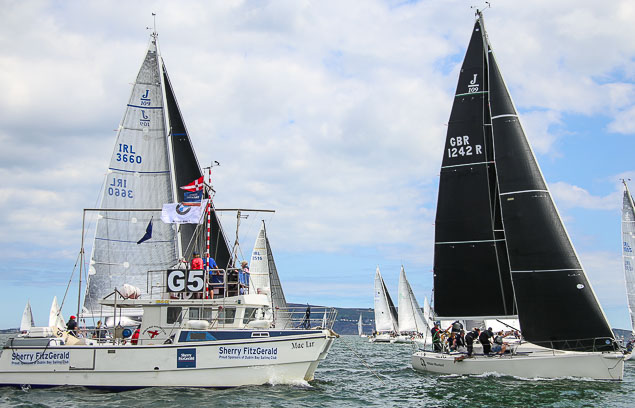 Class One winner – The J109 White Mischief (Tim and Richard Goodbody) took race one by a fine margin after an early tack on to port after a black flag start paid dividends Photo: Afloat.ie
Class One winner – The J109 White Mischief (Tim and Richard Goodbody) took race one by a fine margin after an early tack on to port after a black flag start paid dividends Photo: Afloat.ie
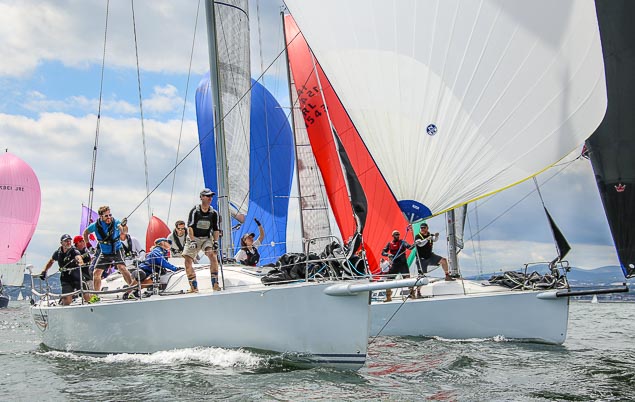 J109 Juggerknot (white spinnaker) and Dear Prudence (black spi) prepare for a gybe and a tight second each (below) in race one Photo: Afloat.ie
J109 Juggerknot (white spinnaker) and Dear Prudence (black spi) prepare for a gybe and a tight second each (below) in race one Photo: Afloat.ie

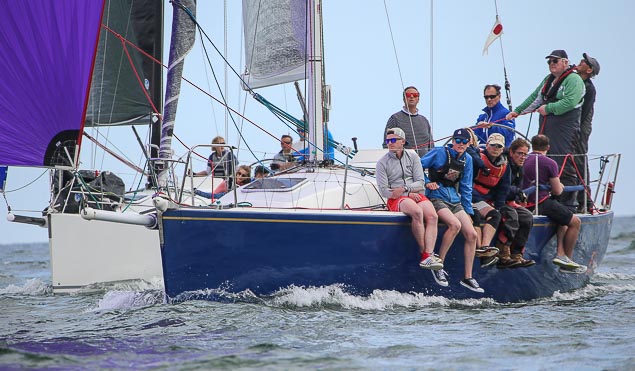 John and Brian Hall from the National Yacht Club in Something Else Photo: Afloat.ie
John and Brian Hall from the National Yacht Club in Something Else Photo: Afloat.ie
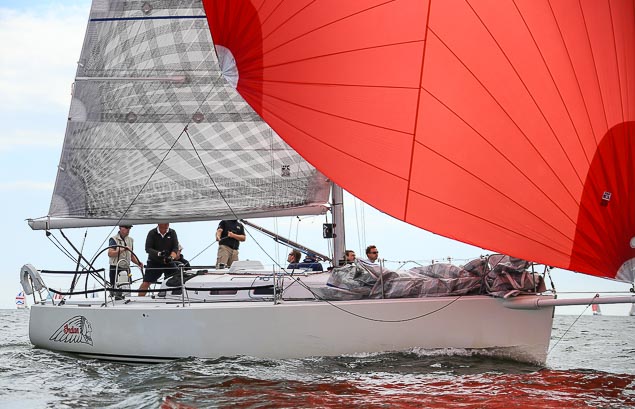 J109 Indian Simon Knowles and and Colm Buckley from Howth Yacht Club Photo: Afloat.ie
J109 Indian Simon Knowles and and Colm Buckley from Howth Yacht Club Photo: Afloat.ie
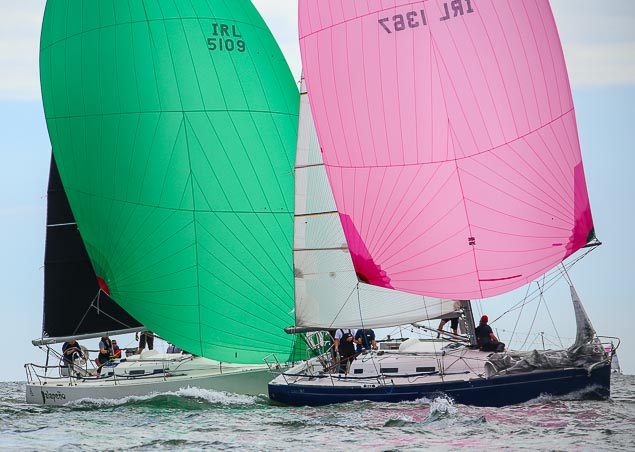 The Kirwan Family's Beneteau 36.7 Boomerang (pink spinnaker) takes on a downwind challenge from Paul Barrington's J109 Jalapeno. The pair finished ninth and eighth respectively overall in class one. Photo: Afloat.ie
The Kirwan Family's Beneteau 36.7 Boomerang (pink spinnaker) takes on a downwind challenge from Paul Barrington's J109 Jalapeno. The pair finished ninth and eighth respectively overall in class one. Photo: Afloat.ie
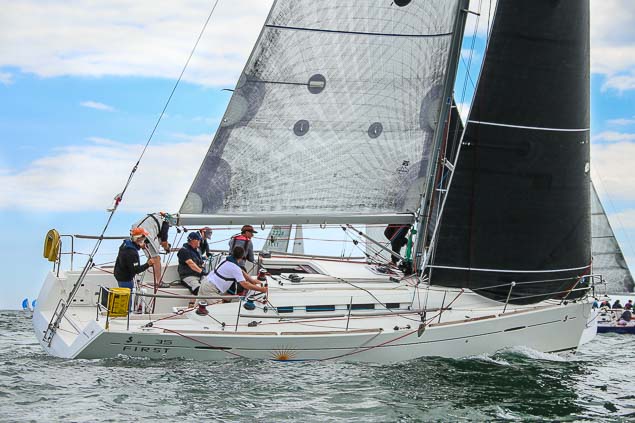 The First 35 Prima Luce (Patrick Burke) of the RIYC was the Class one ECHO winner Photo: Afloat.ie
The First 35 Prima Luce (Patrick Burke) of the RIYC was the Class one ECHO winner Photo: Afloat.ie
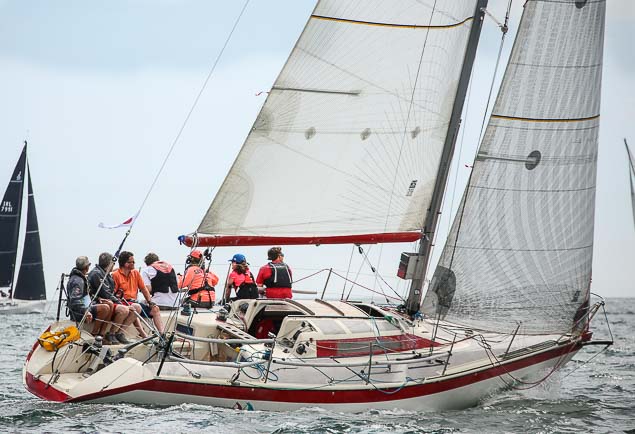 Jonathan Nicholson's DBII Red Rhum from the Royal St. George YC. Photo: Afloat.ie
Jonathan Nicholson's DBII Red Rhum from the Royal St. George YC. Photo: Afloat.ie
The 12-boat class two division was wrapped up again this month by Howth entries. Wave Regatta Champion David Cullen (Afloat's Sailor of the month for June) sailing his Half–Tonner Checkmate XV took both wins to claim the Royal St. George prize from clubmate Mike Evans in The Big Picture. Third was Anthony Gore-Grimes' Howth-based X332 Dux.
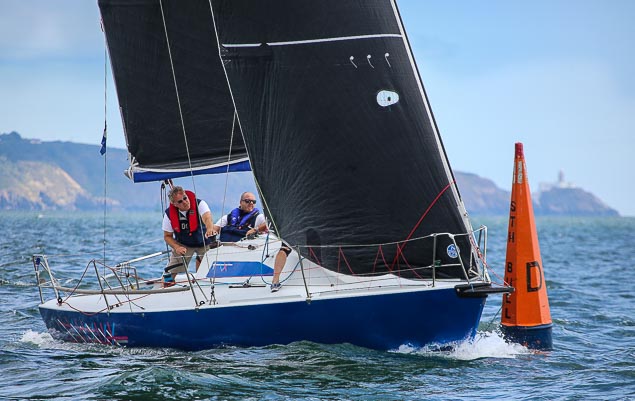 David Cullen's Half–Tonner Checkmate XV from Howth rounds South Bull mark Photo: Afloat.ie
David Cullen's Half–Tonner Checkmate XV from Howth rounds South Bull mark Photo: Afloat.ie
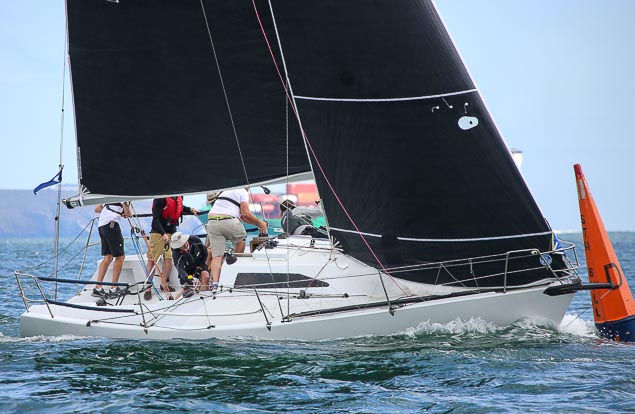 Mike Evans' Half Tonner The Big Picture Photo: Afloat.ie
Mike Evans' Half Tonner The Big Picture Photo: Afloat.ie
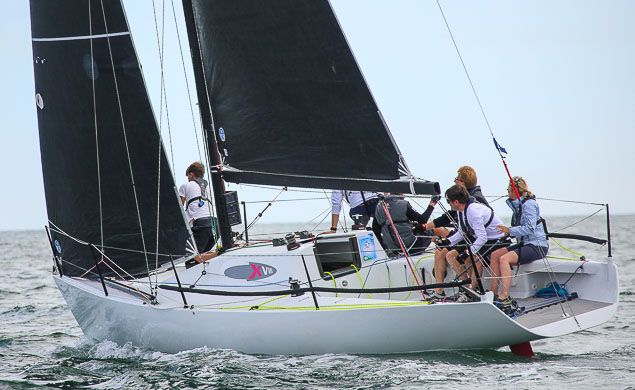 Nigel Biggs' new Checkmate XVIII Dillon Photo: Afloat.ie
Nigel Biggs' new Checkmate XVIII Dillon Photo: Afloat.ie
 Anthony Gore-Grimes' Howth-based X332 Dux Photo: Afloat.ie
Anthony Gore-Grimes' Howth-based X332 Dux Photo: Afloat.ie
In Class three, and in another regatta haul, Ken Lawless and Sybil McCormack's Cartoon from the RIYC was the winner of a five-boat fleet. Royal St. George's Peter Richardson was second in Dubious with clubmate Starlet (K Byrne) third.
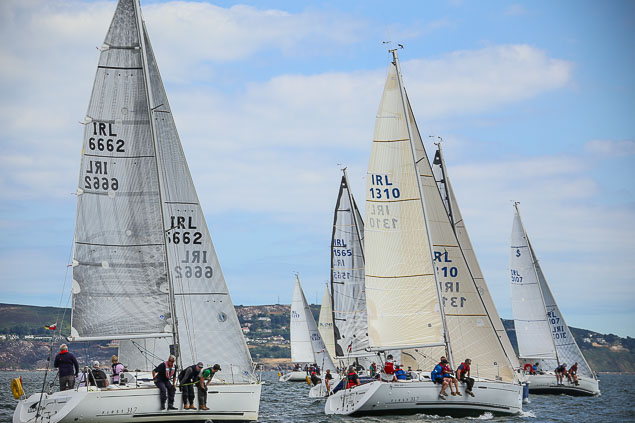 The Beneteau 31.7 race one start Photo: Afloat.ie
The Beneteau 31.7 race one start Photo: Afloat.ie
Frank Heath and Ivan Schuster in Crazy Horse of the RIYC were the scratch winners in the Beneteau 31.7s with a one and a two scored. Royal St. George National Champion Jean Mitton in Levante was second with two thirds. Chris Johnston's Prospect from the NYC was third.
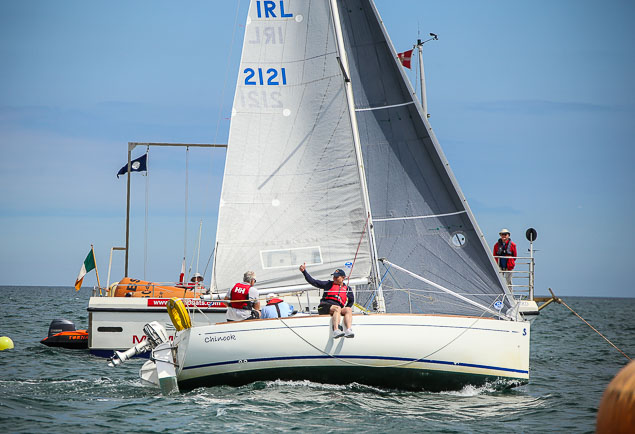 The Beneteau 21 Chinook (A. Bradley) crew celebrate an RStTGYC regatta class win Photo: Afloat.ie
The Beneteau 21 Chinook (A. Bradley) crew celebrate an RStTGYC regatta class win Photo: Afloat.ie
A. Bradley's Chinook won the eight boat scratch battle in the Beneteau 21 class from P. Kingston's Plan B. Third was Greystones Sailing Club's Pete and Anne Evans in Anemos.
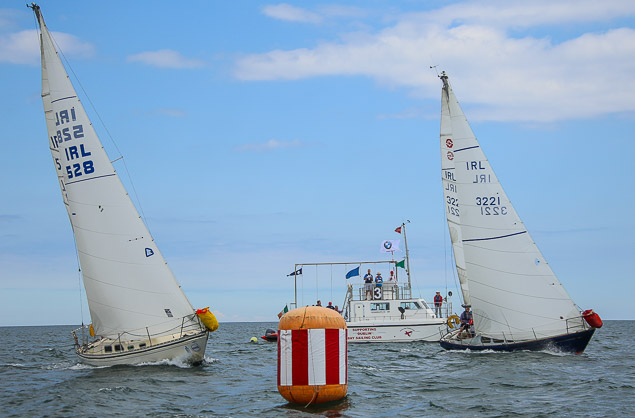 A close finish in the Shipman class Photo: Afloat.ie
A close finish in the Shipman class Photo: Afloat.ie
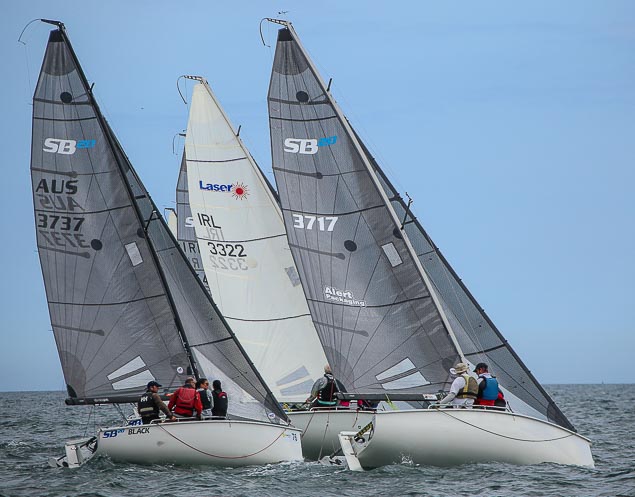 Justin Burke (3717) to weather of a bunch of SB20s moments after the start of the second race Photo: Afloat.ie
Justin Burke (3717) to weather of a bunch of SB20s moments after the start of the second race Photo: Afloat.ie
After the disappointment of fifth overall scored in the SB20 National Championships last weekend on the Bay, Michael O'Connor and his Sin Bin crew were the winners of their own regatta yesterday. The 2017 Corinthian World Champions took the Regatta prize with two straight wins in the eight-boat class that will host its European Championships at the RIYC on the Bay in September.
 The Troy McNamara skippered Royal St. George Yacht Club U sail 1720 was third in the Sportsboat class Photo: Afloat.ie
The Troy McNamara skippered Royal St. George Yacht Club U sail 1720 was third in the Sportsboat class Photo: Afloat.ie
Merlin (I Cummins) from the RIYC was the Sportsboat winner in a seven-boat contest that included some of the waterfront's club-owned 1720s. Andrew Sarratt's Jheeta was second with the RStGYC's Usail 1720 skippered by Troy McNamara third.
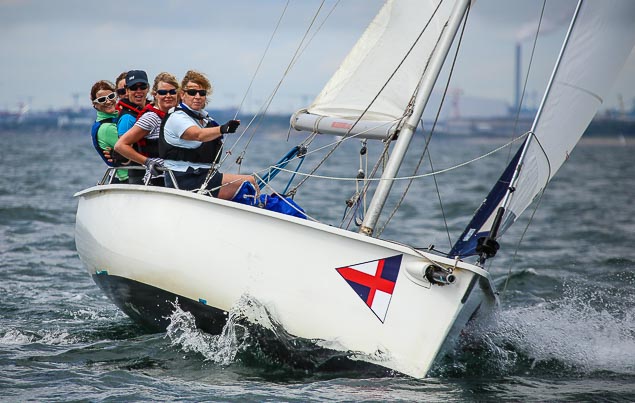 The NYC's women on water crew in the club's 1720 Photo: Afloat.ie
The NYC's women on water crew in the club's 1720 Photo: Afloat.ie
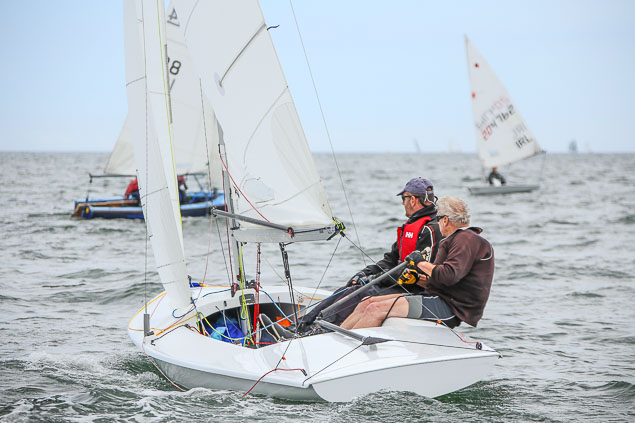 Tom Murphy's Flying Fifteen 'fFlagella' from the NYC Photo: Afloat.ie
Tom Murphy's Flying Fifteen 'fFlagella' from the NYC Photo: Afloat.ie
On the dinghy, Flying Fifteen and Squib course, Niall and Nicky Meagher were winners of a reduced 12-boat Flying Fifteen fleet. Second was DMYC's Neil Colin and Cormac Bradley in Deranged. Third was Chris Doorly's Frequent Flyer.
Howth's David Quinn was the winner of the 11-boat Laser fleet, Ronan Wallace was second and Eoin Delap third.
Masters Radial Champion Sean Craig of the host club was the Radial class winner.
 Sean Craig of the host club was the winner of the 8-boat Laser Radial division Photo: Afloat.ie
Sean Craig of the host club was the winner of the 8-boat Laser Radial division Photo: Afloat.ie
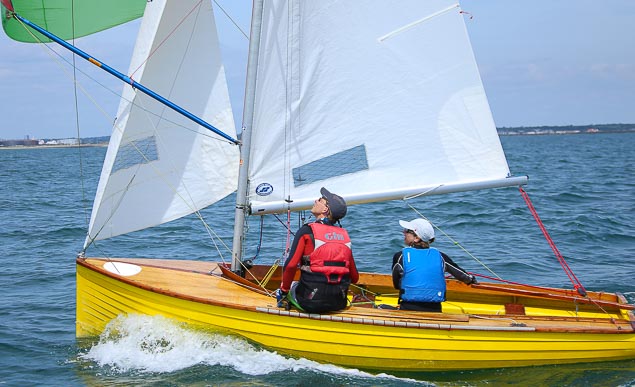 IDRA 14 Dinghy No 122 (Ascoop & Henning) Photo: Afloat.ie
IDRA 14 Dinghy No 122 (Ascoop & Henning) Photo: Afloat.ie
In the five-boat IDRA 14s, B Murphy was the winner from Ascoop & Henning in the distinctive yellow-hull number 125. Frank Hamilton was third in 140, Dunmoanin'.
Full results in all 28 regatta divisions are downloadable below in a PDF file.
This biennial tri-club team racing event championed by the late Harry Maguire for many years was run over the weekend in the Gareloch, Scotland and hosted by the Royal Northern and Clyde YC. The holders Royal St George YC travelled to do battle with Royal Thames and the host club in Sonars. The cumulative age of the team boat crew of four must be 160 years with an opposite gender requirement also providing for a senior more social event. Thames was led by sharp shooter Tom Hebbert (he who wrote the original Team Racing call book with his father Bruce when aged just 16). Fast club sailor and event organiser Nicole McPherson led the RN&CYC. The George helms comprised Ben Cooke and Dragoners Martin Byrne and Neil Hegarty with a supporting crew of nine.
After intensive social interaction the previous night in the Rhu Inn Saturday dawned sunny and with little promise of wind on the glassy Clyde. The towed Sonars were treated in the Gareloch to the sight of a sinister black submarine of unknown nationality and class sailing to base. The George faced Thames in the first match and took early blood. As the racing continued intermittently in the shifting light easterly it required constant course changes. Missed opportunities were rued and windshifts regretted in the tight racing many times only an point deciding the win. The George came out with three wins tied with the hosts and Thames on two; all to play for the following day. A scrumptious dinner was enjoyed in the beautiful Victorian clubhouse which alas is to be vacated by the RN&CYC in 2020 as they are relocating to the Rhu Marina in a new clubhouse. The large overhead in maintaining and preserving a listed building being the driver.
 Racing continued intermittently at the Millennium Bowl event on the Gaeloch in the shifting light easterly
Racing continued intermittently at the Millennium Bowl event on the Gaeloch in the shifting light easterly
Sunday provided even lighter conditions and frustration to the race committee and sailors alike. The first race was abandoned being out of time and the subsequent racing was conducted in zephyrs taxing the concentration of crews. The draw continued with the George and Clyde on 4 wins but the hosts had two races yet to sail. The hapless Thames fell to the Clyde’s superior light weather skills giving them a winning score of 6 wins. A great event in the stunning surroundings was the sailor’s verdict as we bid a sad farewell to the grand old clubhouse.
420 Sailors Get Strong Test at UK Spring Sailing Events
The weather in recent weeks has been variable and has curtailed a number of 420 training weekends around the country but three Irish boats travelled to the UK Spring Championships on the 10th and 11th March at Royal Torbay Yacht Club in the hope of some good sailing. Torbay on the south coast of England brands itself as the 'English Riviera' but the Irish boats arrived to sail in testing conditions. On the Saturday after an initial delay to the sailing whilst the race officer waited for the wind to swing round and the visibility to improve, racing kicked off in 20+ knots and rolling waves.
Link to 420 video from Torbay showing the testing conditions here
There were numerous capsizes, some before the start of race one and a number of DNS/DNC’s appearing across the fleet as sailors struggled with the occasional gust of up to 32 knots recorded on the committee boat. Sunday morning was a lot more promising, the wind had dropped slightly to around 15+ knots and swung round to the east. The bad news was there were now some very larger rollers heading into Torbay. For most sailors it was slightly easier, fewer gusts, and a more consistent wind. Of the top 10 boats, 3 were all girl boats and only 2 were all boys. The other 5 boats all being mixed crews of which 4 of the boats had girls helming, interesting statistics for the sailing community in general. Irish boats finished as follows, 10th overall and 3rd girls were Gemma Mc Dowell and Emma Gallagher of Malahide Yacht Club, 15th Michael O’Suilleabhain and Michael Carroll of Kinsale Yacht Club, and 24th Nicola and Fiona Ferguson of the National Yacht Club.
The second spring event scheduled in the UK was to be the Inland Championships at Rutland Sailing Club on the 17th and 18th March, however the Beast from the East II put paid to this event with strong winds and freezing temperatures. The Irish boats made it back across the Irish Sea before the worst of the weather arrived and in good time for the upcoming 420 Class Open training weekend to be held on the 1st and 2nd April at the National Yacht Club.
The training weekend provides an important warm up to the Volvo Irish Sailing Youth Pathway National Championships 2018 being jointly hosted by the National and Royal St. George Yacht Clubs.
12–Footer Dinghy Class Reunion at Royal St. George Yacht Club, Dun Laoghaire
There will be a dinner and reunion of the international 12 foot class on 6th April 2018 in the Royal St. George Yacht Club at 20.00hrs.
The class is interested in making contact with any owners of these old but lovely dinghies. On the evening, class activist Vincent Delany will launch his book "The International 12 foot Dinghies in Ireland."
Anybody interested in the class or in the April event should contact Vincent Delany at 086 857 5374 or at [email protected]
The Royal St. George Yacht Club saluted its top performers at its Dun Laoghaire Harbour clubhouse on Saturday. The Black Tie gala dinner recognised some outstanding sailing exploits from youth to offshore as well as cruising and team racing achievements in the club's 180th year.
In a special presentation for a significant contribution to the sport, the Waterfront Award went to Dublin Bay Sailing Club's long serving Honorary Secretary, Donal O'Sullivan.
 Donal O'Sullivan (right) receives his award from RSTGYC's Peter Bowring
Donal O'Sullivan (right) receives his award from RSTGYC's Peter Bowring
 Sean Flanagan (right) as outgoing Junior organiser won the Causeway Cup
Sean Flanagan (right) as outgoing Junior organiser won the Causeway Cup
The Club's Causeway Trophy for Sportsmanship went to Sean Flanagan. Flanagan as outgoing Junior organiser was described as 'a true champion for the RStGYC younger sailors and someone 'who worked tirelessly to represent junior interests in the club'.
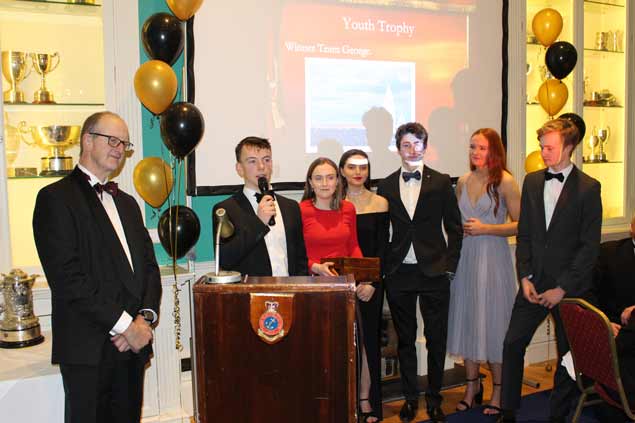 Youth sailor Greg Arrowsmith (with microphone) has been heavily involved in getting young people involved in Team Racing
Youth sailor Greg Arrowsmith (with microphone) has been heavily involved in getting young people involved in Team Racing
The Youth Award went to Team Racing Captain Greg Arrowsmith. The Saint Andrew's College Leaving Certificate student has been heavily involved in getting young people involved in Team Racing. He also organised the Elmo Trophy (Youth Team Racing) for the second year and led the ‘Team George Racing Team’ in the Cup. The award citation on Saturday night said 'the team is a shining example of the success of the revitalised team racing initiative at the club'. Many of the team finished second for the second year running against much more experienced team racers. Team members were Greg Arrowsmith/Sarah Fogarty - Henry Higgins/Emily Arrowsmith - Toby Hudson Fowler/Kathy Kelly.
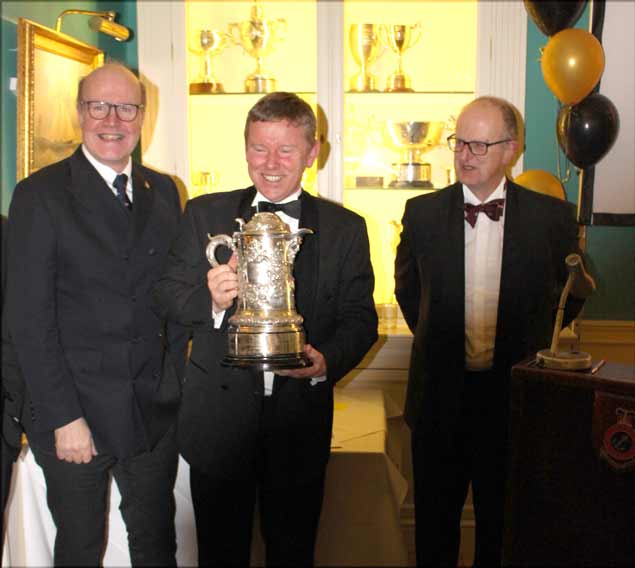 Frank O' Beirne with the O'Hanlon Cup for the best cruise in 2017
Frank O' Beirne with the O'Hanlon Cup for the best cruise in 2017
The O'Hanlon Cup for the best cruise of 2017 went to ‘Samphire’ – Kieron Guilfoyle and Frank O’ Beirne's Anglesey cruise, followed by an extended cruise to Cork and beyond.
The Vice-Commodore's Cup for a significant dinghy performance went to Jack Fahy (Laser Radial Youth). 2017 was a great sailing year for young Fahy. Among his achievements was a first in the Laser 4.7 youth nationals in Ballyholme at Easter, first in the Laser 4.7 Laser Nationals in August, first in the Laser 4.7 Connaughts in Wexford harbour in July. His performance has been recognised by Irish Sailing who invited him to join the Laser Radial Academy.
The Commodore's Cup for the best offshore sailing performance went to ‘Aurelia' (Chris Power Smith). Power Smith's J122 was highly competitive in both the Dun Laoghaire Regatta and the ISORA 2017 series. Aurelia also finished third in the Dun Laoghaire to Dingle Race.
The Enriquetta Cup for significant keelboat performance went to Michael O'Connor in his SB20 ‘Sin Bin’, the Irish National Champion and Corinthian Division winner of the 2017 SB20 World Championships. Hi result of Top Irish boat overall (6th) was the best ever result for an Irish sailor in this event.
Royal St. George Stages 'Final Dinghy Fling' at Dun Laoghaire
An end of Season race for all Dublin Bay Dinghies fleets is taking place on Saturday, 21st October. To be called the 'Final Fling 2017', the new fixture is supported by DBSC and hosted by Royal St. George Yacht Club.
The racing will showcase dinghy racing that takes place on Dublin Bay run by DBSC every Tuesday evening during the summer, according to organiser Ross O'Leary, a DBSC Laser helmsman.
With quick 1-2-3 starts, four sprint races lasting 30 to 35 minutes aim to guarantee some fun, competitive racing.
All fleets welcome. Entry €20 per boat on the day.
An Apres Sail will be held in the Royal St. George Yacht Club.
Register your entry now: email [email protected] text/call/WhatsApp 087 6642297. Download the poster below.
A group of Royal St. George Yacht Club members have 'joined together' to purchase Irish Sailing's ten-year-old J80 fleet on behalf of the Dun Laoghaire harbour Club.
The Royal St. George Yacht Club was one of several bidders for the eight boat fleet that was originally purchased by the then ISA with a Sports Capital Grant at a cost of circa €240k plus VAT in July 2007.
Writing to members to outline the 'exciting development', Club Commodore Michael Pomeroy says the initiative is to 'meaningfully re-engage with the 25 to 50s and to create a less time consuming more value-driven racing environment for young adults'.
Pomeroy also says it will allow the club, one of the largest in the country, to promote corporate sailing and other activities to further increase Club participation. Pomeroy's full statement is on the club website here.
Cora Becomes International 12–ft Dinghy Champion at Royal St. George Event
The International 12 foot and DBSC 12 foot dinghy Irish championships were scheduled, as reported earlier on Afloat.ie, for Dun Laoghaire for the weekend of 10th September 2017. However, the weather forecast was very poor, so, the Royal St. George Yacht Club decided to postpone the event for one week. The two classes of boats have identical hulls, but the International 12 has all the sail area in the mainsail, while the DBSC version has a small jib. The International 12s were approved equipment for the 1920 and 1928 Olympic Games.
Download 2017 Championships results below
The weather on 17th September was ideal, with bright sunshine and a force two breeze from the north. In race one, the International 12s pulled away from the DBSC 12s, with Mark Delany’s Cora a half boatlength ahead of George Millar’s Pixie, as they approached the windward mark. However, Cora was unable to lay the mark, and was forced to gybe away. This handed the lead to Pixie, and dropped Cora to third place behind Gavan Johnson and Gail Varian’s Albany. It took Cora the whole of the next lap to regain her second place. In race two Cora got the best start, and at the windward mark she led from Paul and Tom Gillespie’s Calypso. And the order remained thus until the final beat to the finishing line, when Pixie and Albany managed to overtake Calypso.
The fleet came ashore for a sociable lunch. After lunch, a new course was laid with longer reaching legs, and in the third race, Cora and Albany led around the first windward mark, but the superior offwind speed of the International 12s brought Pixie up into second place, and they retained this order to the finish. In the final race, Pixie needed to win to retain her championship title. Calypso was now being sailed single handed, and she got the best of the start, and held second place behind Cora at the windward mark. Pixie’s superior offwind speed came to the fore again, and she slipped into second place, which she retained to the finish.
Thus, Cora becomes the International 12 ft. dinghy champion and Albany retains her title for as Dublin Bay Sailing Club 12 Ft. dinghy champion.
Royal St. George Yacht Club Trio Now Lying Fourth At SB20 Worlds
Royal St. George Yacht Club's Michael O'Connor, Davy Taylor and Ed Cook are looking for a podium finish at the SB20 World Championships in Cowes today.
The Dun Laoghaire trio are fourth overall and ten points off the lead and four points off the podium after a stunning penultimate day of racing.
O'Connor is in first position for the Corinthian Trophy and beating many of the professional sailors to boot!
The forecast is for light winds again today but who knows what the wind gods will throw at the fleet today.
After four days of racing a new world champion will be crowned this evening at the Royal Yacht Squadron and Ireland is in with a shout.
Competitors got four races yesterday in what turned out to be a windier day than predicted. It was pretty shifty with the breeze varying between 6-25 knots in conjunction with strong tides, making this yet another tricky day of sailing.
With conditions making it hard to be consistent, O'Connor's Dublin Bay–based Sin Bin scored a 2, 3, 6 and 17 to move up from seventh to fourth overall.
it was a tough day for tacticians with no rest from the changeable weather. With a full day of racing now behind us a lot of the top teams are carrying big scores ahead of the final day tomorrow.Now we’ve got one more day to go tomorrow with the potential for an additional three races.
A lot of boats will hope they used their discard up today as there is only one in this final series.
Competitors will compete in the final few races before the new World Champion is crowned tonight.
The results currently stand as follows:
1. Export Roo – Australia
2. Give Me Five! – France
3. Xcellent – Great Britain
4. Sin Bin – Ireland
5. Sportsboatworld.com – Great Britain
6. Marvel – Great Britain
For a full list of results click here
Team Ireland are making a great showing as follows:
4th SINBIN Michael O'Connor, Davy Taylor, Ed Cook
22nd Bad/Kilcullen Stefan Hyde, Jerry Dowling, James Dowling
27th Lia Dave Barry, Cillian Dickson, Gareth Nolan
31st Venuesworld Ger Dempsey, Graeme Grant, Chris Nolan, Diane Kissane
36th Two Men and their Monkey Daragh Sherridan, Shane Murphy, John Phelan
61st Sea Biscuit Marty Cuppage, Niall O'Riordan, Barry Galvin



























